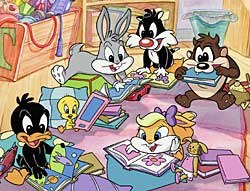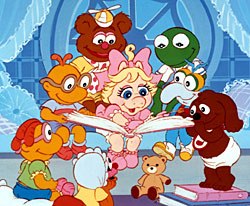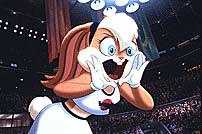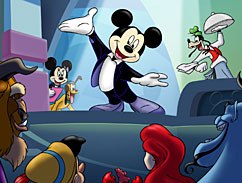Martin “Dr. Toon” Goodman discusses the “babyfication” of cartoon characters and wonders why Warner Bros. has gone back in time with Baby Looney Tunes…

Warner Bros. tries turning back the clock in Baby Looney Tunes. © Warner Bros. Animation.
Perhaps its inevitable; when cartoon characters reach a certain age, they must undergo transformations equivalent to the animated version of the fountain of youth. There are numerous ways to do this: They can be completely reconceptualized, as in Cartoon Networks presentation of Flintstones: On The Rocks. They can be bent to postmodern humor, as Michael Ouweleen and Erik Richter have done with Harvey Birdman: Attorney at Law. They could be simply dusted off and brought back with a shiny new coat of digital ink; witness He-Man and the Masters of the Universe and Transformers. Sometimes they can depict prehistories in which the original protagonists have been recast as their juvenile or baby selves. This option gained wide acceptance during the 1980s and has proven to be the most flawed and aesthetically questionable choice of those listed above.
The Babyfication
Why should this be? Everyone loves little kids and babies, and what better way to build identification with a core audience that consists mostly of children? Both these assumptions may be true, but the concessions are far too great. The first victim in the babyfication of cartoons is usually continuity. One of the clearest examples occurred in The Flintstone Kids (1986-1988), a series that featured the complete revision of a shared history by the characters; they have now known each other since childhood. This twist is in contradiction of backstory provided in a 1964 episode of the original series. Taking a regressive approach to shows also constricts the range of characterization: the players are frozen in developmental lockstep, their futures (and future personalities) already established.
If Reggie Mantle, for example, is a selfless tyke without manipulative tendencies in The New Archies, then what indeed happened to him in the intervening years? Could a fearless prepubescent Shaggy, rather than Fred, truly lead the gang of A Pup Named Scooby Doo through their antecedent adventures and then behave as he did in later years? Probably not. These children will never be exposed, as teenagers are, to the perils of drugs, sexual abuse, satanic or religious cults, skinhead literature, or other murky threats of adolescence. We already know that they have made it through these tumultuous years with their ink-and-paint skins intact. So it goes, through cartoons such as Muppet Babies, Yo, Yogi, and Tom and Jerry Kids.
Perhaps the dreariest feature of these throwback series is the underlying realization that they are less attempts at revisionism than they are vehicles for marketing cuter, alternate versions of established characters. They are also an admission that, bereft of original ideas, studios will copycat each others concepts even if they are less than ideal in the first place. Underscoring this point: The six shows listed above all appeared in the period between 1984-1990. They were all finished as first-run programs by 1993 (or earlier). Happily, the trend of infantilizing cartoon shows gradually died out. The proliferation of animation studios, the rise of creator-driven product, and the availability of cable television markets led to a greater diversity of ideas, helping to kill the much-imitated genre of babyfied cartoons. Well, almost.

Muppet Babies was one of the "throwback" series that came of age in the late '80s. & © 2002 The Jim Henson Company.
Is This Progress?
Few developments in animation this year were more depressing than Warners announcement of Baby Looney Tunes. Not only was a passé idea being revived, but the infantilization of the Looney Tunes gang was actually a throwback to a throwback. Warner had already tried a similar idea in 1990 when they co-produced Tiny Toon Adventures with Steven Spielberg. The main differences between Baby Looney Tunes and Tiny Toons Adventures are that the classic Warner characters are being used rather than their juvenile distant relatives, and that the Baby Looney Tunes are just that -- babies. The featured players are Bugs, Daffy, Tweety, Sylvester, Taz, and a jejune Lola Bunny (who, in yet another twist of continuity, must have existed well before Space Jam). I suppose at this point it is worth noting that Warners two hottest merchandising champs are currently Taz and Tweety. Although Taz is a relative latecomer to the Warner stable and Porky Pig had a fifty-year career at the same studio, there is no baby Porky, his marketing potential having peaked long ago. These twee toons live under the kindly care of Granny, who has un-aged not a bit. An equally important difference is that the once-zany Warner humor is largely absent from Baby Looney Tunes. This is not a series aimed at adults in any way, and is mostly unwatchable by their standards.

Who Framed Roger Rabbit? posited the theory that toons live in a unique universe with its own laws and culture. Courtesy of Disney. © Touchstone Pictures and Amblin Entertainment, Inc.
According to the press release, Baby Looney Tunes will give the audience a peek into how these cherished characters developed their distinct personalities and give Looney Tunes fans a great new opportunity to enjoy them. After viewing several episodes, I had difficulty obtaining this peek. The BLTs appear to be no different to this observers eye than sundry other cartoon babies, although glimpses of Daffys enormous ego are suggested. The stories probably do not help in this regard; were they paced any slower the soundtracks would likely warp. When one watches the Bob Clampett classic The Old Gray Hare and thinks about what could have been done even with this retro concept, one has to mourn. It strains the imagination to believe that the BLTs would grow up into the same characters that were so deftly handled by Chuck Jones, Friz Freleng, or even Bob McKimson. Still, what is to be expected when bad ideas are revived for another go-round?
Part of me regrets showering such denigration on Baby Looney Tunes, a show clearly meant for preschool audiences and the undiscriminating toddler. Mr Whoopie knows, we could certainly use more harmless entertainment for the younger set, especially with attention spans and network airtime in such short supply. I might add that any series featuring lush watercolor backgrounds, modeling shadows on the characters, and a Granny voiced by June Foray cant be a total loss. What I truly bemoan is the frustrating waste of the Warner characters, who are so much more appealing and vital in their mature incarnations.

Back to the future? Baby Looney Tunes offers up a revisionist Lola Bunny, who originally appeared in the 1996 feature Space Jam. Maybe Warners should have developed her into a sexy sophisticate instead? © Warner Bros.
Pauvre Lola! Warners most original character in years, that rare bright spot in the wan film Space Jam, has been reduced to a cuddly caddy of coloring books. I have long wondered why Warner pulled this ravishing rabbit out of its hat only to have her virtually disappear for six long years. Another blown call. Lissome Lola could -- and should -- have been saved for new, more mature cartoons where she could have been developed more in line with her Averian influences; a cool, sexy sophisticate capable of mercilessly lighting Bugs fuse before tamping it out with breezy aplomb and a saucy one-liner. Instead, we get a binky-sucking rugrat, much to the discredit of the very studio that produced some of the most cosmopolitan characters in cartoon history. Why not spend the time and resources of the studio on new episodes that at least make a go of recapturing the cartoon spirit that was truly beloved by three generations of animation fans? Is it really that difficult to script, storyboard and draw fresh farces featuring Bugs, Lola, Daffy, and yes, Porky? This is the studio that produced Animaniacs, right?
A Better Re-Do
Warner might do well to take a look at their longtime competitors Disney in this regard; the studio that once had their thunder stolen by the hipper, funnier Warner cartoons has stolen some of it back. Disneys House of Mouse is by no means the best cartoon series on TV today, but it is an object lesson in how to revise characters without sending them back to childhood. To begin with, the premise makes sense; it is not unreasonable to assume that Mickey, Minnie, Donald, Goofy, and other Disney luminaries would open a nightclub after spending long careers in show business themselves. Their personalities are intact but open to revision; Daisy Duck finally has a definitive voice (and longer hair in the framing sequences), but is recognizably herself with more of a take-charge personality. The cartoons that serve as the centerpieces of the show are of recent vintage, and there is an irreverent, modern flair to them. Some of the 1990s Warner spirit has been appropriated by these Disney cartoons; in one self-reflexive moment, a particularly violent sequence featuring Donald Duck is frozen by three censor monkeys from Broadcast Standards and Practices who demand that the entire scene be re-animated with proper safety devices and equipment in place. Moments later we see exactly that.
I especially enjoyed the shorts pairing Daisy Duck with Minnie Mouse in a love-hate melange of mishaps. Developing new relationships between infrequently paired characters could work equally well for Warner; witness some of the team-ups between Porky and Sylvester during the 1950s. Perhaps its time to give it another go. In one cartoon the classic setup of Mickey, Donald and Goofy as men-for-hire is presented, but this time Goofy goes against type when he angrily demands to be team leader and becomes a dimwitted dictator. Another cartoon pitting Donald against his old adversary the Aracuan bird is almost hallucinatory in nature. Similar cartoons couldnt be made with the classic Warner characters?

Disney used logic when it developed the story line for its animated superstars in House of Mouse. © Disney.
Because House of Mouse has none of the problems in continuity inherent in infantilized cartoons, the fact that Disney characters from different eras are mixed is not a problem. Even if Mickey Mouse predated Ariel by sixty years or so, the latter could not live in the Disney Universe without being aware of who the Mouse was since Mickey clearly came first; thus the little mermaid is not particularly out of place when she attends performances. Better still, she (and other older characters) can be used as material for in-jokes that are some of the shows true delights. The conceit proposed in Who Framed Roger Rabbit? -- that toons live and mingle in an independent, timeless universe -- comes to fruition in House of Mouse, and on the whole it works.
Mickeys nightclub act is not without its flaws; House of Mouse walks a tricky conceptual tightrope in many ways, but the point is, Disney did not have to stoop to infantilization to keep their characters alive, working and funny. Nor did the shows writers have any explaining to do when they revised relationships and characterizations. That, indeed, is the way it should be. We grow, develop, mature and age; shouldnt our favorite characters be allowed to do the same? If Donald Duck becomes a maitre d, Birdman an attorney, or Ralph Bakshis Mighty Heroes middle aged accountants (as they were in one amusing episode of Mighty Mouse: The New Adventures), well, isnt that what the rest of us are doing? Why must our favorite toons be smothered in swaddling cloths or bound by bibs? Nostalgia simply isnt what its cracked up to be; neither are the Baby Looney Tunes nor their animated ilk. While other cartoons are taking giant leaps into the 2000s, it is regrettable to see that Warner animation is taking mere baby steps.

Warner Bros.' Duck Dodgers, premiering on Cartoon Network in 2004, will take the Loony Tunes crew into the next century and early buzz is good! Courtesy of Cartoon Network.
Addendum
After this column went to bed Doc Toon received a press release announcing a new Warners project: Duck Dodgers, which will feature the adventures of a fully-grown Daffy Duck and Porky Pig as they battle old nemesis Marvin Martian (who appears to have left his antigravity playpen far behind). The series is set to debut on Cartoon Network in 2004, and it represents a considerable commitment by Sander Schwartz and Warners to keep the Looney Tunes bunch bouncing into the next decade...or in this case, clean into the 31st century. Well, as Porky might say, "Ask and ye shall recei-recei-recei, eh, get what you wish for!" Kudos to Warners for finally reviving their classic characters the way we best remember and love them.
Martin "Dr. Toon" Goodman is a longtime student and fan of animation. He lives in Anderson, Indiana.








